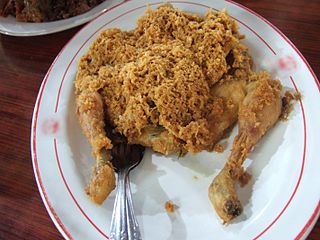
Cooking bananas are banana cultivars in the genus Musa whose fruits are generally used in cooking. They may be eaten ripe or unripe and are generally starchy. Many cooking bananas are referred to as plantains or green bananas, although not all of them are true plantains. Bananas are treated as a starchy fruit with a relatively neutral flavour and soft texture when cooked. Bananas fruit all year round, making them a reliable all-season staple food.

Tapioca is a starch extracted from the storage roots of the cassava plant. This species is native to the north region and central-west region of Brazil, but its use spread throughout South America. The plant was carried by Portuguese and Spanish explorers to most of the West Indies and Africa and Asia. It is a perennial shrub adapted to the hot conditions of tropical lowlands. Cassava copes better with poor soils than many other food plants.

Banana chips are dried, generally crispy slices of bananas. They can be covered with sugar or honey and have a sweet taste, or are more commonly fried in oil and spices and have a salty or spicy taste.

Indonesian cuisine is a collection of various regional culinary traditions that formed the archipelagic nation of Indonesia. There are a wide variety of recipes and cuisines in part because Indonesia is composed of approximately 6,000 populated islands of the total 17,508 in the world's largest archipelago, with more than 300 ethnic groups calling Indonesia home. Many regional cuisines exist, often based upon indigenous culture with some foreign influences. Indonesia has around 5,350 traditional recipes, with 30 of them considered the most important. Indonesia's cuisine may include rice, noodle and soup dishes in modest local eateries to street-side snacks and top-dollar plates.

A fritter is a fried pastry usually consisting of a portion of batter or breading which has been filled with bits of meat, seafood, fruit, vegetables or other ingredients. Fritters are prepared in both sweet and savory varieties.

Kue is an Indonesian bite-sized snack or dessert food. Kue is a fairly broad term in Indonesian to describe a wide variety of snacks; cakes, cookies, fritters, pies, scones, and patisserie. Kue are made from a variety of ingredients in various forms, some are steamed, fried or baked. Kue are popular snacks in Indonesia, which has the largest variety of kue. Because of the countries' historical colonial ties, Koeé (kue) is also popular in the Netherlands.

Emping are a type of Indonesian chips, a bite-size snack kripik cracker, made of melinjo or belinjo nuts. Emping crackers have a slightly bitter taste. Emping snacks are available in markets plain (original), salty, spicy or sweet, depending on the addition of salt or caramelized sugar.

Javanese cuisine is the cuisine of Javanese people, a major ethnic group in Indonesia, more precisely the province of Central Java, Yogyakarta and East Java. Though the cuisine of Sumatra is known for its spiciness with notable Indian and Arabic influences, Javanese cuisine is more indigenously developed and noted for its simplicity. Some of Javanese dishes demonstrate foreign influences, most notably Chinese.

Padang food or Minang food is the cuisine of the Minangkabau people of West Sumatra, Indonesia. It is among the most popular food in Maritime Southeast Asia. It is known across Indonesia as Masakan Padang after the city of Padang the capital city of West Sumatra province. It is served in restaurants mostly owned by perantauan (migrating) Minangkabau people in Indonesian cities. Padang food is ubiquitous in Indonesian cities and is popular in neighboring Malaysia and Singapore.
A great variety of cassava-based dishes are consumed in the regions where cassava is cultivated, and they include many national or ethnic specialities.

Sundanese cuisine is the cuisine of the Sundanese people of West Java, Indonesia. It is one of the most popular foods in Indonesia. Sundanese food is characterised by its freshness; the famous lalab eaten with sambal and also karedok demonstrate the Sundanese fondness for fresh raw vegetables. Unlike the rich and spicy taste, infused with coconut milk and curry of Minangkabau cuisine, the Sundanese cuisine displays the simple and clear taste; ranged from savoury salty, fresh sourness, mild sweetness, to hot and spicy.

Tapioca chips is a snack food made from thin wafers of deep fried cassava root. It is commonly found in South India and Sri Lanka, as well as in Indonesia where it is known as kripik singkong.

Nasi Kapau is a Minang steamed rice topped with various choices of dishes originated from Nagari Kapau, Bukittinggi, a tourism and culinary hotspot town in West Sumatra, Indonesia. It is often describes as Minang version of nasi ramas or nasi campur.

Nasi Padang is a Padang steamed rice served with various choices of pre-cooked dishes originated from Indonesia. It is known across Indonesia as Nasi Padang, after the city of Padang the capital of West Sumatra province. Nasi Padang is a miniature banquet of meats, fish, vegetables, and spicy sambals eaten with plain white rice, it is Sumatra's most famous export and the Minangkabau people's great contribution to Indonesian cuisine.

Ayam goreng is a Indonesian dish consisting of chicken deep fried in oil. Ayam goreng literally means "fried chicken" in Indonesian and Malay. Unlike the Southern United States-style fried chicken, this Southeast Asian version is neither coated in batter nor flour, but rather seasoned rich in various spices.

Kripik or keripik are Indonesian chips or crisps, bite-size snack crackers that can be savoury or sweet. They are made from various dried fruits, tubers, vegetables, and fish that have undergone a deep frying process in hot vegetable oil. They can be lightly seasoned with salt, or spiced with chili powder and sugar.

Krupuk or kerupuk (Indonesian) or kroepoek (Dutch) is a Indonesian deep fried crackers made from starch and other ingredients that serve as flavouring. They are a popular snack in parts of Southeast Asia, but most closely associated with Indonesia. Kroepoek also can be found in the Netherlands, through their historic colonial ties with Indonesia.

A snack is a small service of food and generally eaten between meals. Snacks come in a variety of forms including packaged snack foods and other processed foods, as well as items made from fresh ingredients at home.

Balado is a type of hot and spicy bumbu found in Minang cuisine of West Sumatra, Indonesia. Balado sauce is made by stir frying ground red hot chili pepper with other spices including garlic, shallot, tomato and key lime juice in coconut or palm oil.

















